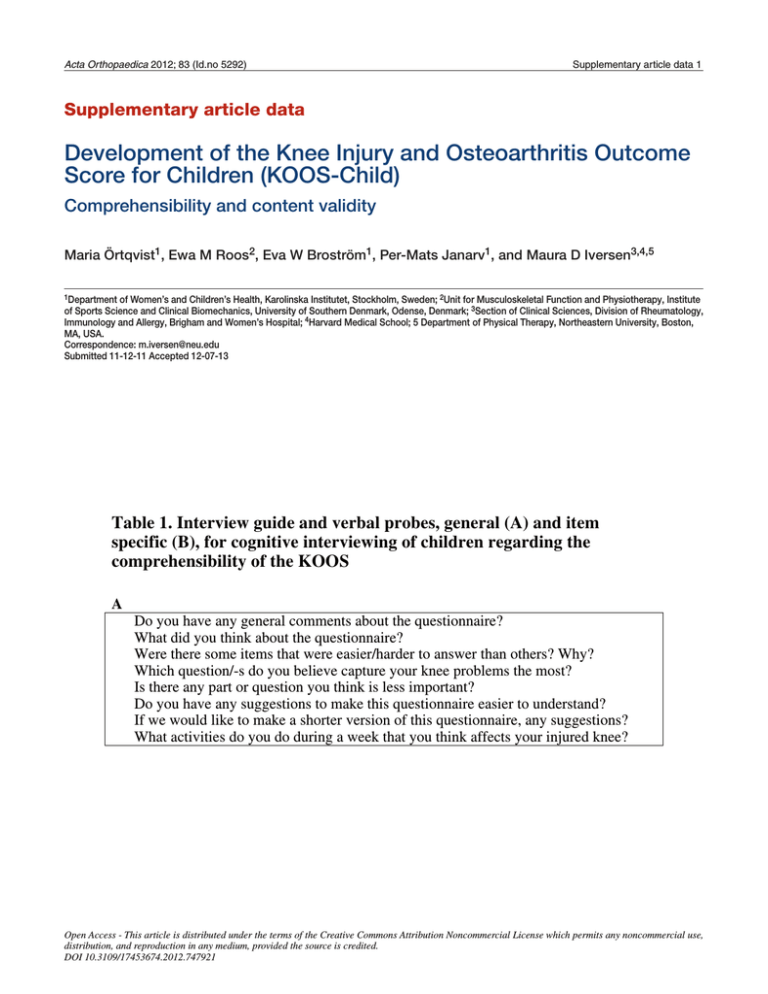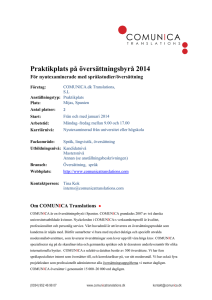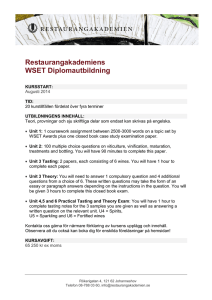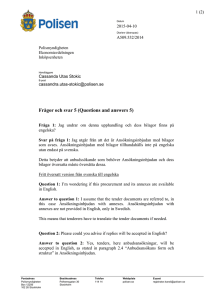KOOS-Child - Acta Orthopaedica
advertisement

Acta Orthopaedica 2012; 83 (Id.no 5292) Supplementary article data 1 Supplementary article data Development of the Knee Injury and Osteoarthritis Outcome Score for Children (KOOS-Child) Comprehensibility and content validity Maria Örtqvist1, Ewa M Roos2, Eva W Broström1, Per-Mats Janarv1, and Maura D Iversen3,4,5 1Department of Women’s and Children’s Health, Karolinska Institutet, Stockholm, Sweden; 2Unit for Musculoskeletal Function and Physiotherapy, Institute of Sports Science and Clinical Biomechanics, University of Southern Denmark, Odense, Denmark; 3Section of Clinical Sciences, Division of Rheumatology, Immunology and Allergy, Brigham and Women’s Hospital; 4Harvard Medical School; 5 Department of Physical Therapy, Northeastern University, Boston, MA, USA. Correspondence: m.iversen@neu.edu Submitted 11-12-11 Accepted 12-07-13 Table 1. Interview guide and verbal probes, general (A) and item specific (B), for cognitive interviewing of children regarding the comprehensibility of the KOOS A Do you have any general comments about the questionnaire? What did you think about the questionnaire? Were there some items that were easier/harder to answer than others? Why? Which question/-s do you believe capture your knee problems the most? Is there any part or question you think is less important? Do you have any suggestions to make this questionnaire easier to understand? If we would like to make a shorter version of this questionnaire, any suggestions? What activities do you do during a week that you think affects your injured knee? B Open Access - This article is distributed under the terms of the Creative Commons Attribution Noncommercial License which permits any noncommercial use, distribution, and reproduction in any medium, provided the source is credited. DOI 10.3109/17453674.2012.747921 2 Supplementary article data Acta Orthopaedica 2012; 83 (Id.no 5292) B S1 S2 S3 S4 S5 S6 S7 P1 P2 P3 P4 P5 P6 P7 P8 P9 A1 A2 A3 A4 A5 A6 A7 A8 A9 A10 A11 A12 A13 A14 A15 A16 A17 SP1 SP2 SP3 SP4 SP5 Q1 Q2 Q3 Q4 What does the word “swollen” mean to you? How would you explain the word “grinding” to a friend? Can you tell me what you believe is the difference between “catch” and “hang up”? Can you repeat this question in your own words? How did you arrive at the answer? How would you explain the concept of “joint stiffness”? What do you think is the difference between this question and #S6? How did you pick the timeframe of this question? How would you explain the activity “twisting/pivoting on your knee” to a friend What would you say is the difference between this question and #S4? What would you say is the difference between this question and #S5? Can you give me an example of a “flat surface”? What do think we mean by asking this question? What do you picture in your mind when answering this question? How difficult did you think it was to answer this question? Why? How did you interpret this question? What do you believe is the difference between this question and #P6? Do you think there is a difference when ascending- or descending stairs? Why? Why do you think we ask this question? How far back in time did you think when answering this question? How would you describe the activity “bending to floor” to a friend? Do you think there is a difference between this question and #P5, Yes/No? Why? Are the answers easy or difficult to understand? Why? How would you think the activity “going shopping” would affect your injured knee? Do you have any suggestions to make the response alternatives easier to understand? What do you think this question means? Try to explain in your own words? Do you have any comments about this specific question? Yes/No? What are your thoughts? What do you believe is the difference between this question and #P7? What do you think this question was asking about? Can you explain the difference between this question and #P8? Do you believe this question is important if you have a knee injury? Why? Why not? Can you give me any examples of “heavy domestic duties” that you do? Can you give me any examples of “light domestic duties” that you do? What does “squatting” mean to you? Please try to restate the response alternatives in your own words. You have several responses to choose from, how did you pick your answer? Can you explain what you believe is the difference between this question and #P2? How would you describe the activity “kneeling” to a friend? Try to explain the response alternatives in your own words? What do you think we mean when we ask this question? What does “moderate” mean to you? What do you think is meant by “In general”? 2 Acta Orthopaedica 2012; 83 (Id.no 5292) Supplementary article data 3 Table 2. Key examples of problems found in the original KOOS when interviewing children and the revised questions in KOOS-child S2. Original question S2. Do you feel grinding, hear clicking or any other type of noise when your knee moves? Never Rarely Sometimes Often Always Comments 32 children (94%) had difficulty understanding the terms “grinding” and “clicking” . Most issues related to the term “grinding”. E.g. -“I do not know, grinding makes me think about when you grind something like a vegetable”. The double-barreled nature of the item was also problematic. E.g. -” It feels like two different questions, I have not felt that it´s grinding but I have heard a sound so I don´t know how to answer...” Revised question S2. During the past 7 days, how often has your knee made any noise/sounds? Never Rarely Sometimes Often Always P6. Original question What amount of knee pain have you experienced the last week during the following activities? P6. Going up or down stairs None Mild Moderate Severe Extreme Comments P6 is a double-barreled question, referring to pain with ascending and descending stairs. Since children reported their pain differed with these two activities, they were unsure how to respond. E.g. -“I get more pain when I walk down stairs and less pain when I walk up stairs”, -“Down does not hurt but up hurts pretty much”, -“I chose "mild" because I have more difficulty walking down stairs, up the stairs is nothing. Go down stairs is difficult”. The two activities have been separated into two items in the new questionnaire. Revised question How much knee pain have you experienced in the past 7 days during the following activities? No A little Some A lot of Extreme pain pain pain pain Pain P6a. Walking up stairs P6b. Walking down stairs 4 4 Supplementary article data Acta Orthopaedica 2012; 83 (Id.no 5292) SP5. Original question The following questions concern your physical function when being active on a higher level. The questions should be answered thinking of what degree of difficulty you have experienced during the last week due to your knee pain. SP5. Kneeling None Mild Moderate Severe Extreme Comments The children had many different ideas about what kneeling meant. E.g. -“Like, lying down on your belly and then you have your knees to the floor” or -“I think you bend your knees backwards and lay on your back”. Pictures have been included in the new questionnaire to illustrate sport and recreational activities. Revised question SP5. During the past 7 days, how much difficulty have you had to kneel because of your injured knee? No difficulty A little Some A lot Extreme difficulty Q4. Original question Q4. In general, how much difficulty do you have with your knee? None Mild Moderate Severe Extreme Comments 18 (53%) children had trouble with the phrase “difficulties in general” with your knee. E.g. -"Generally means like, as in ordinary cases, so before the injury I had like, no problems”, -“How much difficulty do you have with your knee normally”. The children suggested removing this or replacing the word with “overall”. This suggestion was implemented in the new questionnaire. Revised question Q4. Overall, how much difficulty do you have with your injured knee? No difficulty A little Some A lot Extreme difficulty 5 Acta OrthopaedicaKnee 2012; 83Osteoarthritis (Id.no 5292) Outcome Score for Children (KOOS-Child), English version LK1.0 and Supplementary article data 5 Table 4. The revised KOOS-#hild questionnaire in English Today’s date: ___________________ Date of birth: ___________________ Name: _______________________________________________________ INSTRUCTIONS These questions collect information about how your injured knee affects you. Answer every question by ticking the appropriate box, only one box for each question. If you are unsure about how to answer a question, please select the best answer you can. KNEE PROBLEMS S1. During the past 7 days, how often has your knee been swollen? Never Rarely Sometimes Often Always S2. During the past 7 days, how often has your knee made any noise/sounds? Never Rarely Sometimes Often Always S3. During the past 7 days, how often did your knee get stuck? Never Rarely Sometimes Often Always S4. During the past 7 days, how often have you been able to fully straighten your knee on your own? Always Often Sometimes Rarely Never S5. During the past 7, days how often have you been able to fully bend your knee on your own? Always Often Sometimes Rarely Never S6. During the past 7 days, how much difficulty have you had moving your knee just after waking up in the morning? No difficulty A little Some A lot Extreme difficulty S7. During the past 7 days, how much difficulty have you had later in the day moving your knee after being sedentary for a while? None A little Some A lot Extreme P1. During the past month, how often have you experienced knee pain? Never Rarely Sometimes Often All the time 10 6 Supplementary article data Acta Orthopaedica 2012; 83 (Id.no 5292) HOW PAINFUL How much knee pain have you experienced in the past 7 days during the following activities? Check the best answer for each item No pain A little pain Some pain A lot of pain Extreme pain P2. Twisting/pivoting on your injured knee when walking/standing/running P3. Fully straightening your injured knee P4. Fully bending your injured knee P5. Walking on a paved flat surface P6a. Walking up stairs P6b. Walking down stairs P7. If you wake up at night P8a. Sitting with your injured knee bent P8b. Lying down with your injured knee straight P9. Standing upright on both legs for any amount of time DIFFICULTY DURING DAILY ACTIVITIES A1. During the past 7 days, how much difficulty have you had walking down stairs? No difficulty A little Some A lot Extreme difficulty A2. During the past 7 days, how much difficulty have you had walking up stairs? No difficulty A little Some A lot Extreme difficulty A3. During the past 7 days, how much difficulty have you had standing up from a chair? No difficulty A little Some A lot Extreme difficulty 11 Acta Orthopaedica 2012; 83 (Id.no 5292) Supplementary article data 7 A4. During the past 7 days, how much difficulty have you had to stand on both legs? No difficulty A little Some A lot Extreme difficulty A5. During the past 7 days, how much difficulty have you had to bend down and pick up an object from the floor? No difficulty A little Some A lot Extreme difficulty A6. During the past 7 days, how much difficulty have you had to walk on a paved surface? No difficulty A little Some A lot Extreme difficulty A7. During the past 7 days, how much difficulty have you had getting in to/out of a car? No difficulty A little Some A lot Extreme difficulty A8. During the past 7 days, how much difficulty have you had to walk around inside stores? No difficulty A little Some A lot Extreme difficulty A9. During the past 7 days, how much difficulty have you had to put on socks? No difficulty A little Some A lot Extreme difficulty A10. During the past 7 days, how much difficulty have you had to get out of bed? No difficulty A little Some A lot Extreme difficulty A11. During the past 7 days, how much difficulty have you had to take off your socks? No difficulty A little Some A lot Extreme difficulty A12. During the past 7 days, how much difficulty have you had to change knee position when lying in bed? No difficulty A little Some A lot Extreme difficulty A13. During the past 7 days, how much difficulty have you had getting in to/out of the bathtub/shower? No difficulty A little Some A lot Extreme difficulty A14. During the past 7 days, how much difficulty have you had to sit in a chair with your injured knee bent? No difficulty A little Some A lot Extreme difficulty A15. During the past 7 days, how much difficulty have you had getting on/off the toilet? No difficulty A little Some A lot Extreme difficulty 12 8 Supplementary article data Acta Orthopaedica 2012; 83 (Id.no 5292) A16. During the past 7 days, how much difficulty have you had to carry heavy bags /backpacks etc? No difficulty A little Some A lot Extreme difficulty A17. During the past 7 days, how much difficulty have you had to do light chores such as cleaning your room, filling/emptying the dishwasher, making your bed, etc? No difficulty A little Some A lot Extreme difficulty DIFFICULTY DURING SPORTS AND PLAYING SP1. During the past 7 days, how much difficulty have you had to squat down during play or sports activities? No difficulty A little Some A lot Extreme difficulty SP2. During the past 7 days, how much difficulty have you had to run during play or sports activities? No difficulty A little Some A lot Extreme difficulty SP3. During the past 7 days, how much difficulty have you had to jump during play or sports activities? No difficulty A little Some A lot Extreme difficulty SP4. During the past 7 days, how much difficulty have you had to twist/pivot because of your injured knee during play or sports activities? No difficulty A little Some A lot Extreme difficulty SP5. During the past 7 days, how much difficulty have you had to kneel because of your injured knee? No difficulty A little Some A lot Extreme difficulty SPN6. During the past 7 days, how much difficulty have you had to keep your balance when walking /running on uneven ground? No difficulty A little Some A lot Extreme difficulty SPN7. During the past 7 days, how much difficulty have you had playing sports because of your injured knee? No difficulty A little Some A lot Extreme difficulty 13 Acta Orthopaedica 2012; 83 (Id.no 5292) Supplementary article data 9 HOW HAS YOUR KNEE INJURY AFFECTED YOUR LIFE? Q1. How often do you think about your knee problem? Never Rarely Sometimes Often All the time Q2. How much have you changed your lifestyle because of your injured knee? Not at all A little Some A lot Very much A lot Completely Q3. How much do you trust your injured knee? Not at all A little Some Q4. Overall, how much difficulty do you have with your injured knee? No difficulty A little Some A lot Extreme difficulty QN5. How much difficulty have you had getting to school or walking around in school (climbing stairs, opening doors, carrying books, participating during recess) because of your injured knee? No difficulty A little Some A lot Extreme difficulty QN6 How much difficulty have you had to do things with friends because of your injured knee? No difficulty A little Some A lot Extreme difficulty 10 Supplementary article data Acta Orthopaedica 2012; 83 (Id.no 5292) Knee and Osteoarthritis Outcome Score for Children (KOOS-Child), Swedish version LK1.0 Table 5. The revised KOOS-#hild questionnaire in Swedish KOOS-Child knäformulär DATUM: __________________ PERSONNUMMER: ___________________ NAMN: _______________________________________________________ INSTRUKTIONER De här frågorna handlar om hur ditt skadade knä påverkar dig. Svara på varje fråga genom att kryssa för det alternativ du tycker är bäst (endast ett alternativ per fråga). Om du är osäker, kryssa ändå för det alternativ som känns riktigast. KNÄPROBLEM S1. Hur ofta har knät varit svullet de senaste 7 dagarna? Aldrig Sällan Ibland Ofta Alltid S2. Hur ofta har du hört något ljud från knät de senaste 7 dagarna? Aldrig Sällan Ibland Ofta Alltid S3. Hur ofta har ditt knä hakat upp sig (fastnat) de senaste 7 dagarna? Aldrig Sällan Ibland Ofta Alltid S4. Hur ofta har du, utan hjälp, kunnat sträcka knät helt de senaste 7 dagarna? Alltid Ofta Ibland Sällan Aldrig S5. Hur ofta har du, utan hjälp, kunnat böja knät helt de senaste 7 dagarna? Alltid Ofta Ibland Sällan Aldrig S6. Hur svårt har du haft att röra på knät när du vaknat på morgonen de senaste 7 dagarna? Inte alls svårt Lite Ganska Mycket Extremt svårt S7. Hur svårt har du haft att röra på knät om du varit stilla en stund senare under dagen de senaste 7 dagarna? Inte alls svårt Lite Ganska Mycket Extremt svårt P1. Hur ofta har du haft ont i knät den senaste månaden? Aldrig Sällan Ibland Ofta Hela tiden 15 Acta Orthopaedica 2012; 83 (Id.no 5292) Supplementary article data 11 HUR ONT Hur ont har du haft i knät när du har gjort följande aktiviteter de senaste 7 dagarna? Kryssa för det bästa svarsalternativet för varje fråga Inte ont Lite ont Ganska ont Mycket ont Extremt ont P2. Snurra/vrida på det skadade knät när du går/står/springer P3. Sträcka fullt på ditt skadade knä P4. Böja fullt på ditt skadade knä P5. Gå på asfalt P6a. Gå upp för trappor P6b. Gå ner för trappor P7. Om du vaknar på natten P8a. Sitta med ditt skadade knä böjt P8b. Ligga med ditt skadade knä rakt P9. Stå på båda benen, oberoende av hur länge SVÅRIGHETER VID VARDAGSAKTIVITETER A1. Hur svårt har du haft att gå ner för trappor de senaste 7 dagarna? Inte alls svårt Lite Ganska Mycket Extremt svårt A2. Hur svårt har du haft att gå upp för trappor de senaste 7 dagarna? Inte alls svårt Lite Ganska Mycket Extremt svårt A3. Hur svårt har du haft att resa dig från en stol de senaste 7 dagarna? Inte alls svårt Lite Ganska Mycket Extremt svårt 16 12 Supplementary article data Acta Orthopaedica 2012; 83 (Id.no 5292) A4. Hur svårt har du haft att stå på båda benen de senaste 7 dagarna? Inte alls svårt Lite Ganska Mycket Extremt svårt A5. Hur svårt har du haft att böja dig ned och plocka upp något från golvet de senaste 7 dagarna? Inte alls svårt Lite Ganska Mycket Extremt svårt A6. Hur svårt har du haft att gå på asfalt de senaste 7 dagarna? Inte alls svårt Lite Ganska Mycket Extremt svårt A7. Hur svårt har du haft att gå i/ur en bil de senaste 7 dagarna? Inte alls svårt Lite Ganska Mycket Extremt svårt A8. Hur svårt har du haft att gå i affärer de senaste 7 dagarna? Inte alls svårt Lite Ganska Mycket Extremt svårt A9. Hur svårt har du haft att ta på dig strumporna de senaste 7 dagarna? Inte alls svårt Lite Ganska Mycket Extremt svårt A10. Hur svårt har du haft att resa dig från sängen de senaste 7 dagarna? Inte alls svårt Lite Ganska Mycket Extremt svårt A11. Hur svårt har du haft att ta av dig strumporna de senaste 7 dagarna? Inte alls svårt Lite Ganska Mycket Extremt svårt A12. Hur svårt har du haft att ändra läge på knät när du har legat i sängen de senaste 7 dagarna? Inte alls svårt Lite Ganska Mycket Extremt svårt A13. Hur svårt har du haft att gå i/ur badkaret/duschen de senaste 7 dagarna? Inte alls svårt Lite Ganska Mycket Extremt svårt A14. Hur svårt har du haft att sitta på en stol med ditt skadade knä böjt de senaste 7 dagarna? Inte alls svårt Lite Ganska Mycket Extremt svårt A15. Hur svårt har du haft att sätta dig och resa dig från toalettstolen de senaste 7 dagarna? Inte alls svårt Lite Ganska Mycket Extremt svårt 17 Acta Orthopaedica 2012; 83 (Id.no 5292) Supplementary article data 13 A16. Hur svårt har du haft att bära tunga väskor, ryggsäck eller liknande de senaste 7 dagarna? Inte alls svårt Lite Ganska Mycket Extremt svårt A17. Hur svårt har du haft att bädda sängen, städa ditt rum, plocka i/ur diskmaskin eller liknande de senaste 7 dagarna? Inte alls svårt Lite Ganska Mycket Extremt svårt SVÅRIGHETER VID LEK OCH IDROTT SP1. Hur svårt har du haft att gå ner på huk när du har lekt eller idrottat under de senaste 7 dagarna? Inte alls svårt Lite Ganska Mycket Extremt svårt SP2. Hur svårt har du haft att springa när du har lekt eller idrottat under de senaste 7 dagarna? Inte alls svårt Lite Ganska Mycket Extremt svårt SP3. Hur svårt har du haft att hoppa när du har lekt eller idrottat under de senaste 7 dagarna? Inte alls svårt Lite Ganska Mycket Extremt svårt SP4. Hur svårt har du haft att snurra/vrida på det skadade knät när du har lekt eller idrottat under de senaste 7 dagarna? Inte alls svårt Lite Ganska Mycket Extremt svårt SP5. Hur svårt har du haft att sitta på knä under de senaste 7 dagarna? Inte alls svårt Lite Ganska Mycket Extremt svårt SPN6. Hur svårt har du haft hålla balansen när du har gått/sprungit på ojämn mark de senaste 7 dagarna? Inte alls svårt Lite Ganska Mycket Extremt svårt SPN7. Hur svårt har du haft att vara med på sportaktiviteter på grund av din knäskada under de senaste 7 dagarna? Inte alls svårt Lite Ganska Mycket Extremt svårt 18 14 Supplementary article data Acta Orthopaedica 2012; 83 (Id.no 5292) HUR HAR DIN KNÄSKADA PÅVERKAT DITT LIV? Q1. Hur ofta tänker du på ditt skadade knä? Aldrig Sällan Ibland Ofta Hela tiden Q2. Hur mycket har du ändrat ditt sätt att leva på grund av ditt skadade knä? Inte alls Lite Ganska Mycket Väldigt mycket Q3. Hur mycket kan du lita på ditt skadade knä? Helt och hållet Mycket Ganska Lite Inte alls Q4. Hur mycket problem har du med ditt skadade knä över huvudtaget? Inga alls Små Mitt i mellan Stora Mycket stora QN5. Hur svårt har du haft att ta dig till eller runt i skolan (gå i trappor, öppna dörrar, bära böcker, vara med på rasten) på grund av ditt skadade knä? Inte alls svårt Lite Ganska Mycket Extremt svårt QN6. Hur svårt har du haft att göra saker med vänner på grund av ditt skadade knä? Inte alls svårt Lite Ganska Mycket Extremt svårt 19



